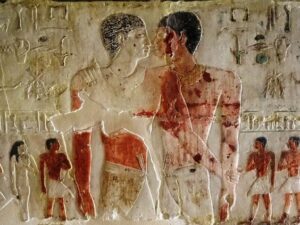Long before our modern alphabet of LGBTQ+ was etched into our collective consciousness, love, and desire in their many forms danced freely through the lives of mortals and immortals alike. The fluidity of these emotions, as boundless as the sea and as unpredictable as the wind, found its reflection in the mythologies that shaped our ancestors’ understanding of the world. These tales, spun from the threads of divine inspiration and human experience, cradled expressions of queerness with a reverence that resonates profoundly even today.
Divine Diversity
From the mystical heights of Mount Olympus to the icy expanses of the Norse fjords, tales of gods and goddesses who defied the conventional norms of gender and sexuality were etched into the fabric of myth. They loved, desired, and lived in ways that blended the boundaries between masculine and feminine, transcending the restrictions of binary identities. These were divine beings who dared to embody the full spectrum of love and desire, illuminating the sacredness of queer identities in cultures that celebrated, rather than stifled, diversity.
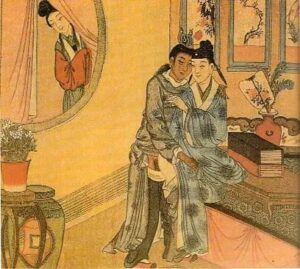
These ancient myths serve as a reminder of a time when queer identities were honored openly, rather than marginalized. They encourage us to explore our shared history, uncovering the acceptance that may have been forgotten but still exists within our collective consciousness. As we delve into these stories of LGBTQ+ gods and goddesses, we rediscover a wisdom as ancient as the cosmos itself: that love, in all its forms, is as divine as the gods and goddesses who bear testament to its boundless potential.
Ancient Acceptance: The Spectrum of the Divine
When we look at mythology, it is obvious that different sexual orientations did not present a societal issue. Many cultures embraced fluid concepts of gender and sexuality without imposing rigid labels. People experienced love and desire in various forms, and myths reflected this acceptance. Figures we will talk about later in the article, exemplified diverse expressions of sexuality and identity. Instead of stigmatizing these variations, ancient societies often celebrated them, recognizing the spectrum of human experience as natural and divine. This inclusiveness highlights a stark contrast to the more restrictive views that emerged in later historical periods.
Ancient Greece
Greek mythology thus brims with tales of gods who do not conform to modern heteronormative standards. These stories remind us that the boundaries of love and desire are fluid, transcending societal constructs and norms.
Dionysus
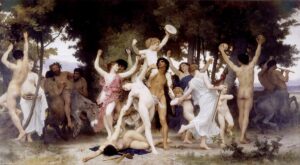
In the pantheon of Greek deities, Dionysus stands out as a god associated with sexual fluidity. Wine, celebration, and ecstasy fall under his realm, and the Greek concept of ecstasy involved not only a state of divine madness but also a blurring of sexual identities. Ancient plays reveal Dionysus dressed in female clothing and using his powers of persuasion to enthrall both men and women. His followers, the Maenads, also defied the traditional female role with their wildness and physical strength, embodying aspects of the masculine.
Nonbinary Hermaphroditus
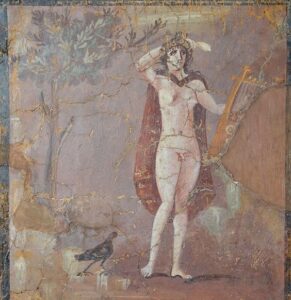
The tale of Hermaphroditus takes us on a journey into the realm of the androgynous. Born from the union of Hermes and Aphrodite, Hermaphroditus draws the masculine and the feminine together in a single form. A nymph named Salmacis fell passionately in love with Hermaphroditus and wished to unite with him forever. The gods granted her wish, merging Hermaphroditus and Salmacis into a single being, a being that forever symbolizes the union of male and female characteristics. And yes, Hermaphroditism gets its name from them.
Zeus
As the king of the gods, Zeus demonstrated his romantic and sexual attractions without restrictions. Several of his famous affairs involve young, beautiful men, such as Ganymede, a Trojan prince. Zeus transformed into an eagle to carry Ganymede to Olympus, where he became Zeus’s lover and the cupbearer of the gods. This myth has served as a central piece of homoerotic art and literature for millennia.
Poseidon
Poseidon, the formidable god of the sea, also harbored love beyond heteronormative bounds. In one legend, he pursued the beautiful youth Pelops, who later became an accomplished charioteer. Their relationship, seen as passionate and intense, mirrors the tempestuous nature of the sea itself.
Pan
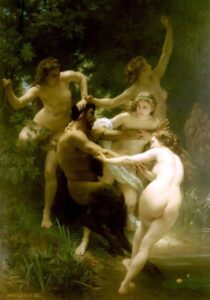
Pan, the rustic god of the wild, embodies sexual energy without boundaries. The myths portray him with a persistent and pervasive desire for nymphs, gods, and mortals alike, regardless of their gender. The stories of Pan echo the primal, all-encompassing nature of desire.
Aphrodite
The goddess of love and beauty, manifests an all-embracing love that transcends binary gender roles. Born from the sea foam after the castration of the sky god Uranus, her very origins hint at a complexity of gender. Aphrodite often dictated the love lives of other gods and mortals, weaving spells that sparked both heterosexual and homosexual desires. Her ability to control desire makes her an emblem of love’s omnipresence and diversity.
Hindu Mythology
These LGBTQ+ examples from Hindu mythology emphasize acceptance and understanding of diverse gender identities and sexual orientations. They illustrate how ancient societies embraced and revered this diversity, portraying it in their divine figures and epic tales.
Shiva and Parvati
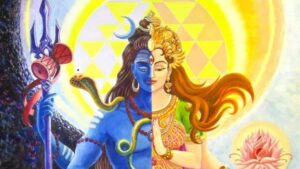
In Hindu mythology, Shiva and Parvati come together in a divine form known as Ardhanarishvara. This form represents a perfect fusion of masculine and feminine energies. Ardhanarishvara embodies the principle that male and female elements are inseparable. The deity offers an ancient representation of gender fluidity, suggesting an understanding of non-binary identities.
Shikhandi
Shikhandi is a central character in the epic Mahabharata. Born as a woman named Shikhandini, she became a man through a divine intervention. Shikhandi’s transformation was crucial in the Kurukshetra war. He was the reason for the fall of Bhishma, a warrior who could not be defeated by any man. Shikhandi’s story reflects the themes of transgender identity and transition.
Another character in Hindu mythology is Mohini. Mohini is a female avatar of the god Vishnu, known to bewitch both mortals and gods. In one legend, Mohini and Lord Shiva gave birth to Lord Ayyappa. This tale emphasizes sexual fluidity, depicting a male god giving birth while in a female form.
Ancient Egypt
Egyptian mythology features Set, the god of chaos, who holds intriguing characteristics related to LGBTQ+ themes. In one tale, Set and his nephew Horus engage in a series of battles for the throne. In these disputes, both gods use their sexuality as a weapon to humiliate the other. This story has been interpreted as containing homoerotic elements.
Another deity, Hapi, the god of the Nile, holds a connection to both genders. Representations of Hapi often depict him with breasts and a rounded belly, features associated with fertility. This depiction straddles the line between male and female, embodying the life-giving power of the Nile River.
The goddess Isis also presents a queer narrative. In a story where her husband, Osiris, is dismembered, she uses her magic to recreate his body. Despite missing one crucial piece, she conceives their son, Horus. This story represents an ancient form of assisted reproduction, a concept that resonates with many in the LGBTQ+ community.
Gods of Rainbow

These LGBTQ+ examples can be multiplied. Among the Nordic gods Loki, a shape-shifter, doesn’t limit himself to a single gender or species. In one myth, he transforms into a mare, mates with a powerful stallion, and gives birth to an eight-legged horse named Sleipnir. Loki, in the role of a mother, breaks conventional gender roles, highlighting the fluidity of his gender and sexual identity. Also, Japanese mythology features the story of the deity Inari, associated with foxes, fertility, and agriculture. Inari often appears as a bearded man, a beautiful woman, or even an androgynous bodhisattva. This deity demonstrates gender fluidity and is a fitting symbol for transgender and non-binary identities of LGBTQ+ community.
These mythological characters and their queer stories should not be ignored. Because mythology is very important to understand the perspectives of ancient people on life. For example Friedrich Nietzsche, showed a profound interest in Greek mythology and its impact on human life. He saw Greek myths not just as fantastical tales, but as deeply human stories that offered crucial insights into the human condition and societal norms.
Love Is Love
In Nietzsche’s view, Greek mythology was an accurate mirror reflecting daily life in ancient Greece. The gods, with their intense emotions, conflicting desires, and complicated relationships, exhibited the same complexity and unpredictability as human beings. For Nietzsche, these gods were humanity’s own invention, embodying the fears, desires, ambitions, and conflicts experienced by people.
Nietzsche is not wrong. Mythology is such a human thing that we still refer to its characters for many emotions and situations today. Because the essence of human emotions never changes.

